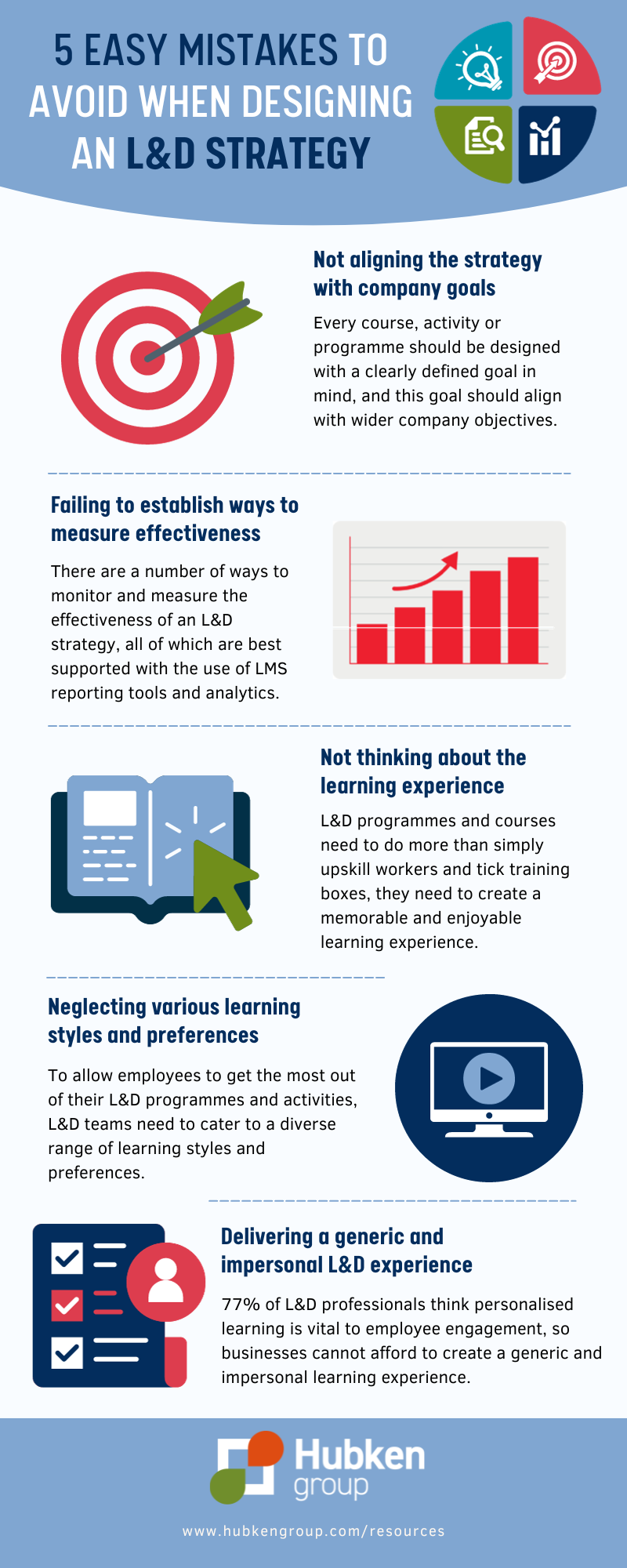L&D is a vital function that empowers employees by helping them grow their knowledge base and develop new skills. However, without careful planning and a well-thought-out strategy, L&D teams cannot expect to yield the best results and drive the company towards success. When designing an L&D strategy, there are a number of common mistakes that businesses often run into, hindering the learning process and weakening the L&D function as a result. In this blog, we share five common mistakes and how to avoid them using e-learning tools and technology.
Not aligning the strategy with company goals
When carried out correctly, the positive impact of L&D practices will be felt across all functions of the business, strengthening the entire organisation as a result. With this in mind, it’s vital when designing an L&D strategy to align it with wider company goals and objectives.
Every course, activity or programme should be designed with a clearly defined goal in mind and these goals should align with wider company objectives. For example, a training programme designed to help employees develop management skills should also support the company’s succession planning strategy.
When an L&D strategy doesn’t align with wider company objectives and goals, it can slow down the growth and success of an organisation as it doesn’t address the specific needs and requirements of the business. To avoid this, L&D teams must converse with key stakeholders to understand what these wider objectives and goals are and what needs to be done to achieve them. Using the Goals function in a learning management system (LMS) such as Totara Learn, L&D teams can create goals for learners and connect them with other goals at an organisation level. With tools such as goal scales, goal frameworks and goal types, L&D goals can be highly detailed with clear progress markers and objectives that can be set for individuals or entire teams.
Find out more about Totara Learn’s robust e-learning tools and functions.

Failing to establish ways to measure effectiveness
Even with the most powerful L&D programmes and tools and high-quality training content, failing to establish ways to measure their effectiveness can undermine their impact and weaken the L&D strategy.
There are a number of ways to monitor and measure the effectiveness of an L&D strategy, such as competency scales, KPIs, and feedback mechanisms - all of which are best supported with the use of LMS reporting tools and analytics. LMS reports can be custom-built to monitor areas such as sign-on rates and course completion rates, which can help L&D teams identify poor engagement levels.

LMS assessments are a highly effective way to measure the effectiveness of L&D programmes by testing learner knowledge and monitoring knowledge acquisition and retention at an individual or team level. Using automatic reports, admins can gain instant insights into learner progress, identifying individuals with low assessment scores or measuring the effectiveness of a course by analysing assessment scores across the entire group.
Discover 5 ways to get the most out of e-learning assessments.
Not thinking about the learning experience
A common mistake that many organisations make when designing an L&D strategy is failing to think about their employees’ learning experience. L&D programmes and courses need to do more than simply upskill workers and tick training boxes, they need to create a memorable and enjoyable learning experience. When L&D teams focus on the learning experience, they can expect to see stronger engagement levels and boost motivation levels, resulting in a higher level of employee satisfaction.
An effective way to create a better learning experience is to focus on training content. Using e-learning tools, L&D teams can deliver highly immersive and interactive content that requires learners to play an active role in the learning process. And content such as gamified lessons and branching scenarios can significantly improve the learning experience, resulting in higher retention rates.
Deliver a highly engaging learning experience by following these top tips.
Neglecting various learning styles and preferences
To allow employees to get the most out of their L&D programmes and activities, L&D teams need to cater to a diverse range of learning styles and preferences. For example, if an L&D strategy is entirely made up of simple text training materials, this will impede the learning process for employees who learn best from auditory training content. Using e-learning content allows L&D teams to cater to various learning styles, with content types such as video, podcasts, blogs, and gamification.

It's also imperative that L&D teams accommodate various learning preferences when designing an L&D strategy. While some employees may prefer to learn autonomously using an LMS, some may prefer group projects or instructor-led training. L&D teams may wish to overlap training methods or change the delivery depending on the subject matter of a course, catering to each employee as a result.
When learning is carried out in a work environment, many employees will prefer to learn in the flow of work, allowing them to carry out their daily tasks whilst also completing L&D activities. To allow for this, L&D teams can build a microlearning strategy into the wider L&D strategy, meaning that employees can complete short microlessons throughout the day – building L&D into the flow of work.
What is microlearning? Read our ultimate guide.
Delivering a generic and impersonal L&D experience
77% of L&D professionals think personalised learning is vital to employee engagement, so businesses cannot afford to create an L&D strategy that delivers a generic and impersonal learning experience. One way to prevent this is to ensure that all L&D content feels like an extension of the business, with branding, tone, and company culture in mind. This personalised content can be created in-house using LMS content creation tools or by acquiring bespoke content from a third-party developer.
Using an LMS, L&D teams can create personalised learning pathways that cater to the individual needs and training requirements of each employee by delivering the relevant L&D content. Additionally, the hierarchies feature in an LMS such as Totara Learn allows organisations to map out personalised learning requirements to job positions, teams, and departments by mirroring the infrastructure of the business and distributing content based on a predetermined set of criteria – creating a targeted and personalised learning experience.
Transform your training with bespoke e-learning content: Watch our webinar to find out more.
Avoid the mistakes that will weaken your L&D strategy by implementing a powerful Hubken solution
To maximise the effectiveness of your L&D strategy and avoid the above mistakes, you need a robust e-learning solution with the right tools and functionality that can support key activities and processes. From powerful reporting tools to complex automation technology, our e-learning platforms offer everything you need to ensure your L&D strategy drives operational success and empowers your learners. Visit our product pages to find out more or get in touch with one of our in-house e-learning experts today.

Contact Hubken today
Quick responses and clear advice, we're here whenever you need us. Our friendly e-learning specialists are ready to help and will be in touch shortly after you've sent your message.

.png?width=1080&height=150&name=Slim%20blog%20CTAs%20(16).png)
.png?width=1080&height=150&name=Slim%20blog%20CTAs%20(12).png)



